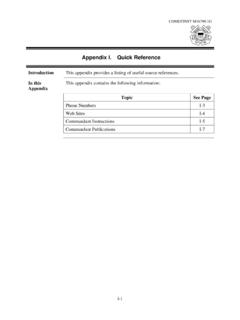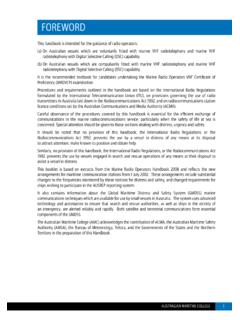Transcription of RADIO PROCEDURES for DISTRICT 11sr U.S. COAST GUARD ...
1 1 RADIO PROCEDURES for DISTRICT 11sr COAST GUARD AUXILIARY VHF REPEATER SYSTEM NETWORK Roy L. Lay - DSO-CM July 2011 Authorization for the establishment of the Eleventh DISTRICT ( 11sr ) COAST GUARD Auxiliary VHF RADIO System ( AUXNET) is in accordance with requests made by CCGD Eleven and approvals granted by appropriate government agencies. The COAST GUARD Auxiliary VHF RADIO System is to be used for the following purposes: 1. Administrative messages related to COAST GUARD Auxiliary Business; 2. Member Training; 3. Emergency Communications; and 4. Support of Auxiliary activities at local levels. Prior to 2007 most radios used on Auxiliary frequencies were converted or expanded amateur RADIO transceivers FCC type accepted under Part 97 (Amateur) specifications.
2 Effective 1 January 2007 the Federal government re-allocated all VHF commercial and government frequencies (not marine) and at the same time specified that they be used in narrow-band mode with a channel spacing of kHz instead of 25 kHz. To ensure compliance with the performance specifications of narrow-band radios a requirement was created that all radios used on Auxiliary frequencies must meet the technical specifications of FCC Part 90 type accepted equipment. Part 90 is the standard for Land Mobile RADIO (LMR) equipment in commercial use by taxis, tow trucks, etc. Therefore all VHF radios offered for use as Auxiliary Communications Units (ACU s) must be FCC Part 90 type accepted. Amateur RADIO equipment can no longer be used. The System is not to be used as a substitute for personal telephone messages unrelated to Auxiliary functions or for the type of personal communications typical of those on Amateur RADIO repeaters.
3 Administration of the Eleventh DISTRICT (SR) Auxiliary VHF RADIO System is the direct responsibility of the DISTRICT Staff Officer - Communications (DSO-CM) and the Director of Auxiliary. Additional members of the Eleventh DISTRICT (SR) Auxiliary may be appointed by the DSO-CM as necessary to maintain the various technical and operational aspects of the system. 2 A. USER QUALIFICATIONS Applicants for NET call signs and authorization to operate RADIO equipment on assigned simplex and repeater frequencies must meet the following qualifications: 1. Be a Basically Qualified (BQ) or AUXOP member in good standing; 2. Have successfully completed the current TCO-PQS, or the Auxiliary Communications Specialty Course prior to 1 August 2008 ; and 3.
4 Be willing to operate along guidelines set forth in this publication and other Auxiliary Communications manuals. B. CALL SIGNS Call signs are required to identify each qualified member authorized to use the RADIO system. Use of systematically assigned call signs eliminates the need to use first or last names, staff symbols, or other identifiers in order to address a discussion to a specific person. Call signs are issued by the DSO-CM from blocks of two-letter combinations from AB through ZZ. Requests for call sign issue shall be directed to the DSO-CM through the appropriate FSO-CM and SO-CM. Requests received without the necessary endorsements will be returned. Special call signs will not be issued on the basis of office held, past office, status, rank or similar recognition of past or present authority.
5 Call signs are assigned to qualified members, not to their stations or radios. Individuals are to use their own call signs regardless of who owns the particular equipment being used, except when operating equipment at Auxiliary-owned or relay stations. AUXNET call signs are separate from, and different than, RADIO facility call signs. There is an AUXNET call sign directory on the DISTRICT web site under Operations/Communications. 3 C. USER PROFICIENCY AND STATION CAPABILITIES Users are encouraged to use the system for administrative messages and training in a manner similar to those which are used in regular operational communications. PROCEDURES established for use on this system are essentially the same as those used on regular COAST GUARD calling and working frequencies.
6 Only through frequent use of, and proper adherence to, these PROCEDURES can proficiency be maintained. The Auxiliary VHF RADIO System is not approved for use in Operations such as a SAR case. This means that communications relative to a SAR case in progress must be directed to the regular COAST GUARD Sector or Station handling the case on the assigned primary VHF-FM Marine frequency as directed by the or in control of the case. Regarding Auxiliary aircraft patrols, the guarding of the aircraft while patrolling over water or responding to SAR cases is performed on the assigned frequency of MHz. Marine VHF-FM Channel 83a. Preparation or coordination of vessel and aircraft patrols or training exercises and other special activities using the Auxiliary VHF RADIO System is considered administrative and therefore permissible.
7 As a rule of thumb, operational facilities on an actual SAR mission must direct all communications affecting the mission to the cognizant COAST GUARD Sector/Station and not to the Auxiliary Direction Finding Stations. Likewise, any direction finding information determined by the Direction Finding Stations must be directed to the COAST GUARD Sector or Station via landline. Unless otherwise directed by the COAST GUARD , direction-finding must never be transmitted over Marine frequencies. This line of communication is necessary in order that the COAST GUARD receives the latest and most complete information in order to coordinate the mission. NOTE: If the primary means of communication fails or becomes difficult at best, the Auxiliary VHF RADIO System may be used as a back-up system.
8 For aircraft patrols, this rule applies after primary frequency channel 83a ( ) and secondary VHF-AM Aeronautical frequency ( MHz) have both failed. 4 D. STATION IDENTIFICATION All COAST GUARD Auxiliary frequencies are considered government frequencies and are controlled by the COAST GUARD , not the Federal Communications Commission. The COAST GUARD requires that each transmitting station be: 1. Identified as being associated with the COAST GUARD ; 2. Uniquely identified as to who is the operator; and 3. Identified at frequent intervals not to exceed five minutes. These requirements are necessary to allow rapid identification of the source of transmissions in the event such transmissions may be causing interference with other services.
9 The words "station" or " RADIO " should not be used when identifying. These are only used by inspected Auxiliary Communications Units (ACU) operating under COAST GUARD orders. Only the assigned NET call sign will be used in identifying. Use of your facility s name, aircraft tail number, ACU call sign, etc., is not authorized. E. CONTACTING ANOTHER STATION The initial call to a station shall include the full call of the station being called and the abbreviated call of the calling station. Example: " COAST GUARD AUXILIARY ALFA BRAVO, THIS IS ALFA CHARLIE, OVER." The first response to such a call would be: "THIS IS COAST GUARD AUXILIARY ALFA BRAVO, OVER." If a station does not respond to an initial call, a second attempt should be made. This is in case the operator missed the call (out of the room, ambient noise, etc.)
10 Subsequent transmissions during a contact may be made without ID or with abbreviated call signs. 5 EXCEPTION: Stations must identify with their full call sign at least every five minutes during a contact. This also applies to all stations in a roundtable net. The ICAO/Military phonetic alphabet must be used with call signs at all times. There should be a pause of two seconds after a station has said "over" before the next transmission starts. This allows the repeater to "re-set" and prevent overheating due to prolonged conversations. A single transmission lasting longer than 10 minutes without a break will cause the repeater to time out and stop transmitting until it resets. The last word of every transmission should be either "OVER" or "OUT", but never both.














